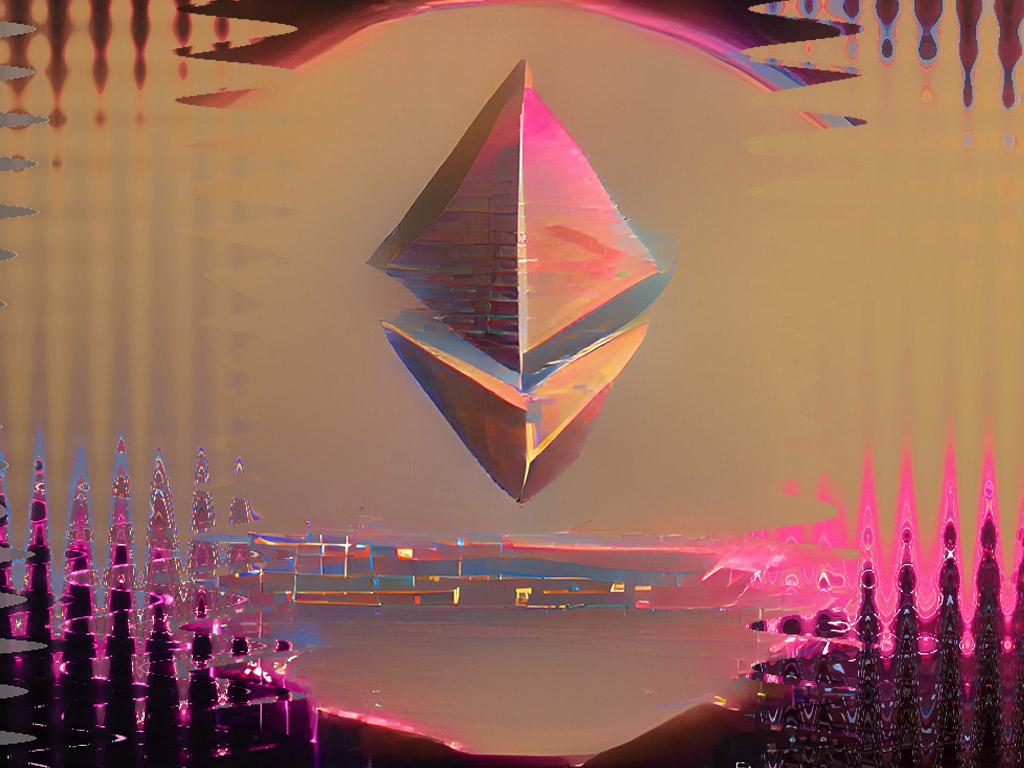Ethereum is a globally decentralised platform secured by blockchain technology. It allows anyone to build applications and transact digital assets, like cryptocurrencies, without the need for a central authority. Cryptocurrency has been a hot topic in recent years, and rightfully so. Digital assets secured by cryptography and stored on an immutable ledger, known as a blockchain, have developed to become a new way to send and receive money. Born from the ashes of the GFC in 2008, Bitcoin was the first cryptographically secured digital asset. Not long after its creation, more cryptocurrencies began to appear.

In 2015, a new cryptocurrency project called Ethereum was launched. What is Ethereum and how is it any different to Bitcoin? Ethereum is similar to Bitcoin in that it was designed to facilitate the transfer of digital assets with no middleman, but it has one major difference: it’s programmable.
Ethereum allows anyone to build and deploy decentralised applications (dApps) on its network, which lets them utilise the benefits of blockchain technology to store data and control their app. This gives programmers more potential, and with no need for centralised permission, some of the smartest minds in the world have begun innovating the next generation of decentralised applications and financial products.
What is Ethereum?
Ethereum is a digital platform that allows anyone to build applications, create organisations, provide financial products, hold assets and transact with others without the need for approval from any central authority. It utilises blockchain technology to decentralise, secure and immutably store the transaction history of all activities on the network.
A blockchain is a distributed ledger of information that is stored across many different computers on the same network. Every time a certain amount of information, or transactional data, needs to be stored, it is added to the ledger in a ‘block’. Blocks are added on top of previous ones, forming a chronological chain of transactions, hence the name ‘blockchain’. By distributing this information across many different computers, the Ethereum blockchain ensures that once the data is added, it cannot be altered or removed.
All computers must reach a consensus before adding a new block, meaning that they all agree their copy is the same as everyone else’s. If a bad actor decided to alter the information, they would need to alter the information on the majority of computers in the network. For extremely established blockchains with a very large, decentralised network of computers (like Ethereum), this would be practically impossible. For this reason, Ethereum is seen as one of the most secure and, consequently, popular blockchains.
With so many blockchains in existence today, Ethereum is fundamentally unique because it was the first to introduce the idea that blockchains could be used for more than simply peer-to-peer transactions. By building on the fundamentals of crypto, the Ethereum blockchain not only allows for peer-to-peer transactions but also allows anyone to program any kind of application they can think of. This has led to an unbelievable level of innovation, where creativity is the only limit.
Ether and Ethereum: what’s the difference?
You will often hear the words Ethereum and Ether being used interchangeably, but it’s important to note that they are actually two distinct things.
When people talk about ‘Ethereum’ as a cryptocurrency, they’re actually talking about Ether (ETH), which is the native currency of the Ethereum network. ETH is the fuel that powers the network’s transactions. Blockchains use a ‘native asset’ as a method to secure the network, as a form of digital value transfer and as a reward for contributing members of the decentralised computer network. Every transaction on the Ethereum network requires a fee paid in the native asset, ETH, to have its information stored on the network.
This fee goes to the computers in the network as a reward for participating, storing and securing Ethereum. The current method of consensus, called Proof-of-Work (PoW), is energy intensive and costly for the computers in the network, so their rewards are also boosted by ETH issuance. However, Ethereum moved in 2022 to a much more energy-efficient method of consensus called Proof-of-Stake (PoS). This change will mean rewards will no longer need to be boosted with inflation and will be entirely supported by network fees.
Ethereum price
When Ethereum was launched, 59 million units of the native token ETH were sold at an initial price of US$0.31, raising approximately US$18 million for the Ethereum Foundation to continue working on the network. The price of ETH stayed below $20 for several years, but in 2017, the market truly began to understand the real value of a programmable, decentralised blockchain. The price exploded from low double digits in early 2017 and surged all the way to $1500 by the start of 2018, an impressive 7400% gain. Soon after, the price fell drastically, and for the majority of 2018 and 2019, ETH’s price remained within a range of US$100-200.
In 2020, after the initial crash in all markets caused by the Covid-19 pandemic, the price of ETH began to rise once again. Fuelled by an enormous influx of fiscal stimulus from central banks worldwide, ETH and the entire cryptocurrency market pushed to new highs. In late 2021, ETH peaked at a price of just under US$5000. Since then, ETH and the majority of crypto assets have been in a downtrend, largely influenced by the less favourable economic conditions caused by fiscal tightening and high levels of inflation.
Pros and cons of Ethereum
The foundations of Ethereum are decentralisation, security and programmability. This approach has pros and cons, both of which we’ll go into below.
Pros
- Most established, battle-tested programmable blockchain of its kind
- Highly decentralised
- Secure due to the high value of the network
- Has the largest number of active developers working on it
- Has the most liquidity of any programmable blockchain
- Has the largest number of crypto-assets available on the chain
Cons
- High transaction fees, especially during times of network congestion
- Difficult to scale the underlying infrastructure to increase throughout
How to buy Ethereum
As the second largest cryptocurrency by market cap, ETH is readily available for purchase on the vast majority of all exchanges.
Steps to buy ETH
- Sign up for a trusted exchange that is compliant in your local jurisdiction. It is important to ensure you use a reputable exchange as there have been cases of fraudulent exchanges.
- Once you have signed up for the exchange, you may need to complete a know-your-customer (KYC) process. This often involves providing a full name, image of a government issued ID and answering some security questions.
- After the signup and KYC is completed, you should now be able to deposit funds onto the exchange. Different exchanges offer different deposit methods from card to bank transfer, so choose what option is right for you.
- Once you have deposited the funds you wish to invest, you can now buy ETH on the exchange. It is important to determine the amount of ETH you are able to purchase, taking the price at the time into consideration.
- It is recommended you immediately transfer your assets from your exchange to your digital wallet or hardware wallet (preferred) as centralised exchanges are more vulnerable to hacks.
Ethereum transaction fee
The transaction fees on the Ethereum network are paid in ETH and known as ‘gas fees’. Gas fees are the payment made for the processing power required to add the transaction to the blockchain. The process of adding additional blocks containing transaction data to the blockchain is energy intensive. As a result, the payment is compensation for the physical ‘labour’ of the computers in the network.
How do gas fees work on Ethereum?
The gas fees to complete a transaction on the Ethereum network fluctuate depending on many different factors, although the major factor tends to be network usage.
When a lot of people are all using the Ethereum network, there are lots of transactions trying to get added to each new block. The recently added EIP-1559 introduced a new fee structure. Each block now has a ‘base fee’ for a transaction. For users who want to prioritise their transaction, a ‘tip’ component can be added. The base fee is ‘burnt’, reducing the supply of ETH every time someone makes a transaction and the ‘tip’ goes to the validators as a reward. The validators in the network will always favour the transactions that have paid the highest tip.
Gas fees are also impacted by the complexity of the transaction. For a simple transfer from one wallet to another, the gas fee is on the lower end of the spectrum, whereas a complex transaction utilising a smart contract in a DeFi protocol will likely cost a lot more.
How to stake Ethereum
Staking Ethereum is not for the uninitiated. Previously, Ethereum use a PoW consensus mechanism, which didn’t require the staking of assets in order to validate the network. However, The Merge saw it shift to a PoS consensus mechanism, which utilises validators that are activated by staking some ETH in return for a portion of the transaction fees from transactions.

Staking ETH is now possible following The Merge. To run a validator (the name given to software that is responsible for storing data, processing transactions and adding new blocks to the blockchain), you must lock-up 32 ETH and run a hardware setup with sufficient processing power and data storage capabilities.
Solo staking can be quite daunting, as dropping 32 ETH, roughly US$60,000 at the time of writing, isn’t for the faint of heart. If you’d still like to participate in validating the network and earning some rewards in return, staking providers such as Rocketpool and Lido will stake your ETH for you and distribute the rewards after taking a small cut. Additionally, the Ethereum foundation website includes further details about the types of staking in which you can take part.
How to mine Ethereum
Mining Ethereum requires a dedicated hardware setup that can be quite costly and probably isn’t the best long-term decision, with the move from PoW to PoS consensus mechanisms just around the corner. Due to the high upfront cost of the mining equipment, it is unlikely that starting to mine Ethereum now will generate enough revenue to cover that cost.
The Merge (formerly Ethereum 2.0)
The Merge, often (unofficially) called ‘Ethereum 2.0’ is the recently completed upgrade to Ethereum, and which is said to have improved its,potential scalability and sustainability. The former PoW consensus mechanism used by Ethereum had its benefits, although its high energy usage and low transaction capacity were seen as major drawbacks to the network’s long-term use.
The transition to PoS dropped the energy usage of Ethereum by 99.95% and is argued by some to further decentralise the network by providing lower barriers to entry for validators of the network (stakers). Due to the reduced cost to be a validator, less ETH issuance will be required to incentivise validators, leading to less ETH inflation.
The future
The Merge is the largest upgrade in Ethereum’s history and marked the beginning of the next generation of blockchain technology The first upgrade was the launch of the Beacon Chain, which was the initial stage of the move to PoS. The Merge led to the end of POW consensus by merging the Beacon Chain, which is PoS, to the main chain. The final stage, called ‘Sharding’, will occur post-Merge and is aimed at increasing the scalability and capacity of Ethereum.
Ultimately, the value of Ethereum goes far beyond being ‘internet money’ and verges on bringing about a new way of conducting finance. If banks are the financial plumbing that connect us and others with money, it’s not hard to see that the pipes have gotten rusty, and centralised institutions don’t seem all that concerned with the 1.7 billion people and 200 million businesses around the world that are currently financially unserviced.
As a platform built on a decentralised blockchain that allows anyone to build any application they can think of and transfer value globally with no middleman, Ethereum grants unparalleled and unprejudiced access to financial and technological innovators in every corner of the world.





